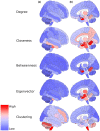A comprehensive anatomical network analysis of human brain topology
- PMID: 36691774
- PMCID: PMC10184545
- DOI: 10.1111/joa.13828
A comprehensive anatomical network analysis of human brain topology
Abstract
A network approach to the macroscopic anatomy of the human brain can be used to model physical interactions among regions in order to study their topological properties, as well as the topological properties of the overall system. Here, a comprehensive model of human brain topology is presented, based on traditional macroanatomical divisions of the whole brain, which includes its subcortical regions. The aim was to localise anatomical elements that are essential for the geometric balance of the brain, as to identify underlying phenotypic patterns of spatial arrangement and understand how these patterns may influence brain morphology in ontogeny and phylogeny. The model revealed that the parahippocampal gyrus, the anterior lobe of the cerebellum and the ventral portion of the midbrain are subjected to major topological constraints that are likely to limit or channel their morphological evolution. The present model suggests that the brain can be divided into a superior and an inferior morphological block, linked with extrinsic topological constraints imposed by the surrounding braincase. This information should be considered duly both in ontogenetic and phylogenetic studies of primate neuroanatomy.
Keywords: brain morphology; morphological integration; network theory; topological constraints.
© 2023 Anatomical Society.
Figures







Similar articles
-
A comparative anatomical network analysis of the human and chimpanzee brains.Am J Biol Anthropol. 2024 Sep;185(1):e24988. doi: 10.1002/ajpa.24988. Epub 2024 Jun 15. Am J Biol Anthropol. 2024. PMID: 38877829
-
An inclusive anatomical network analysis of human craniocerebral topology.J Anat. 2024 Nov;245(5):686-698. doi: 10.1111/joa.14068. Epub 2024 Jun 1. J Anat. 2024. PMID: 38822698
-
A network approach to brain form, cortical topology and human evolution.Brain Struct Funct. 2019 Jul;224(6):2231-2245. doi: 10.1007/s00429-019-01900-1. Epub 2019 Jun 12. Brain Struct Funct. 2019. PMID: 31190163
-
Three brain collections for comparative neuroanatomy and neuroimaging.Ann N Y Acad Sci. 2011 May;1225 Suppl 1:E94-104. doi: 10.1111/j.1749-6632.2011.05978.x. Ann N Y Acad Sci. 2011. PMID: 21599701 Review.
-
Human Paleoneurology and the Evolution of the Parietal Cortex.Brain Behav Evol. 2018;91(3):136-147. doi: 10.1159/000488889. Epub 2018 Aug 10. Brain Behav Evol. 2018. PMID: 30099459 Review.
Cited by
-
Advancements in the investigation of the mechanisms underlying cognitive aging.Biogerontology. 2025 Aug 10;26(4):158. doi: 10.1007/s10522-025-10300-4. Biogerontology. 2025. PMID: 40783909 Free PMC article. Review.
References
-
- Barabási, A.‐L. & Albert, R. (1999) Emergence of scaling in random networks. Science, 286, 509–512. - PubMed
-
- Bastian, M. , Heymann, S. & Jacomy, M. (2009) Gephi: an open source software for exploring and manipulating networks. Burnaby, Canada: PKP Publishing Services Network.
-
- Bastir, M. , Rosas, A. , Stringer, C. , Manuel Cuétara, J. , Kruszynski, R. , Weber, G.W. et al. (2010) Effects of brain and facial size on basicranial form in human and primate evolution. Journal of Human Evolution, 58, 421–431. - PubMed
Publication types
MeSH terms
LinkOut - more resources
Full Text Sources

